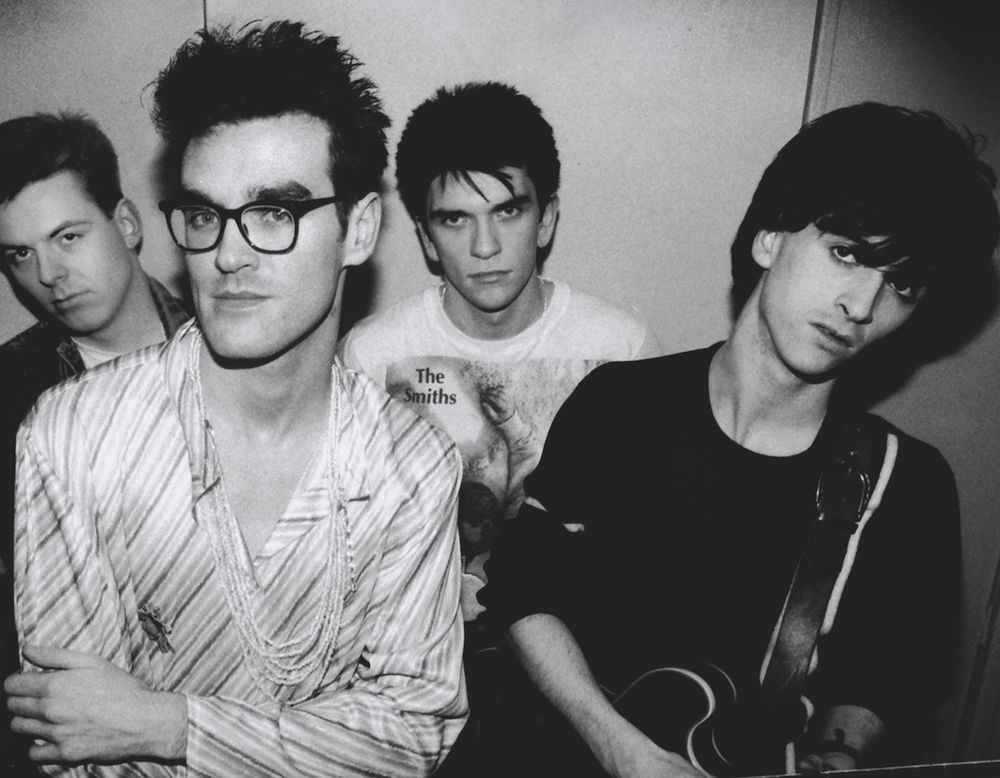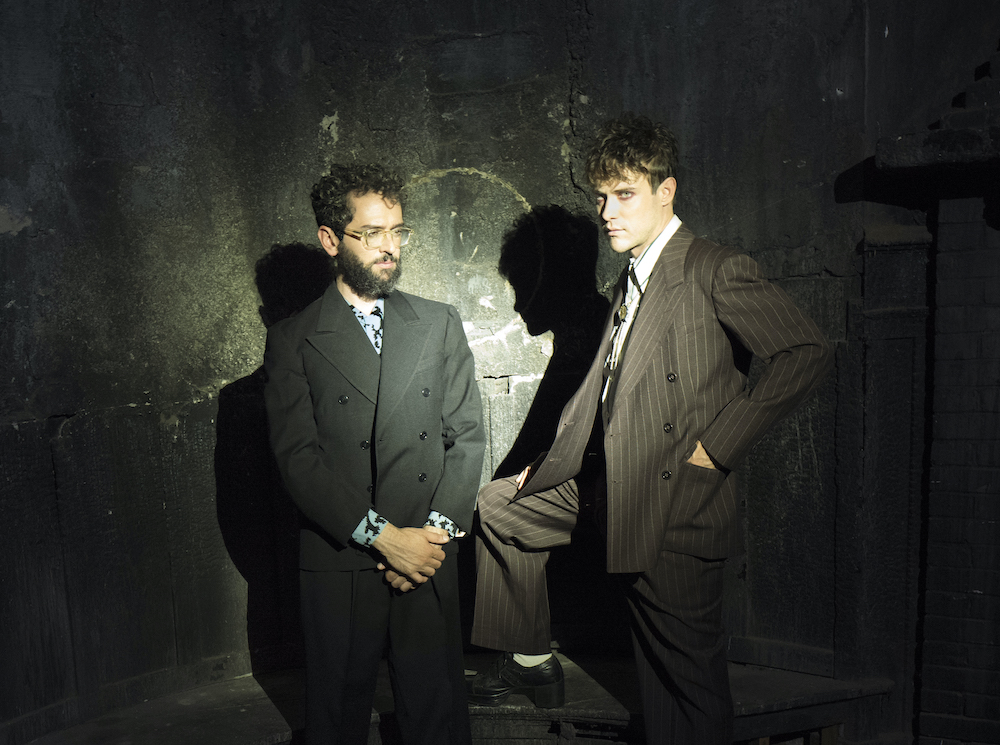When Dirty Projectors mastermind and bandleader Dave Longstreth sings about being "in the gray mesh shorts" of his alma mater, honestly, I freak out a little bit. When he croons, "I boogied down gargoyle streets, searching in every face for something I can believe," my stomach burns. Every time I hear about how his "college smells like vomit," I can't help but laugh and nod.
I'd been listening to the Dirty Projectors well before I shared an alma mater with Longstreth -- who famously dropped out of school to pursue his career in music -- but being around campus and listening to his band's catalog put things into an interesting perspective. Because soon enough, at school, I found myself kicking around the gargoyle streets, running in gray mesh shorts, and throwing up in dorm stairwells myself. I took biology on the "science hill" in "Off Science Hill." And for me, anyway, he was right -- about everything.
Longstreth's lyrics are littered with that kind of anxiety that would draw someone away from a set path: anxieties about death, and potential, and loneliness; yearnings for love, and success, and fire, and some sleep. He was exactly right about feeling 21 and wanting to do something that probably won't pay well. And the craziest thing is that he got me feeling those things before I even got to school.
More often than not, the Dirty Projectors are painted as a band for music eggheads, which I guess is sort of true. Longstreth's classical acumen (much of which, I am told, he picked up in undergrad classes) shows in his string arrangements, his dizzying polyrhythms, his mastery of chords. The DP's sound is a constantly evolving blend of skittering guitar patterns sitting over winding synth brushes and devilishly dissonant vocal lines; harmonies are as unexpected as they are perplexing. NPR even poked at the band a bit, calling them often "too eager to show off their smarts." So it's not unheard of that the Dirty Projectors' sound is too complex for comfort, too cerebral.
The fact is, though, that the Dirty Projectors are a band full of soul and hot blood. If there's anything egghead-y or too complicated in their sound, it's just the way that Longstreth's hyperactive and brilliant brain sorts through all of that raw emotional potential. From their dustiest and poppiest of ditties to their strangest and most transmogrifying suites, the Dirty Projectors are a band caught in a death match between the head and the heart. This is a band constantly trying to reconcile their most visceral feelings -- romantic, desperate, unabashed -- with the Big Questions. Fate and fulfillment; love and loss; entropy and order.
Even from their sloppy and grand debut record, The Glad Fact (conceived in Longstreth's dorm room in 2003), this was clear. It was definitely precocious, and often a stretch, but fresh, and a pretty good indicator of where the band would go. On the joint EPs Slaves' Graves & Ballads (2004), the band explored both the orchestral and acoustic, bare-bones intricacies of their earlier release, trying out (it seems) as many different and kooky combinations of chords and instruments as possible. Lyrically and thematically, Longstreth probes the depths of his unbendingly weird mind, producing high-concept albums like 2005's The Getty Address, about Don Henley (huh?), and 2007's Rise Above, a reinterpretation of the 1981 Black Flag album by Longstreth after fifteen years without hearing it.
In recent years, the DPs have taken a turn toward pop. Or, something like it. Their 2009 breakthrough record Bitte Orca was a dazzling collection of baroque electric guitar. Almost instantly, its release had Solange covering the band, Jay Z hiring the band to play his festival, and Stereogum wondering whether it was the best album of 2009. Their latest release, Swing Lo Magellan (2012), is an even more song-centric album: jittery, gaunt, and often surprisingly happy, it is maybe the culmination of the band's experimentation with pop structures.
But while their latest two albums may be their most accessible, they are not the band's only releases grounded in both emotion and mental acuity. The feelings I got from the band, even before retracing Longstreth's steps, were real, and human. The Dirty Projectors have been testing limits since day one: How strange can a tune be and still keep people dancing? How plain can a track be and still keep people thinking?
Unfortunately, with a collection so full of wonder, I had to exclude some of their collaborative work (like their crazy-spectacular joint EP with Bjork, among others) when creating this list. But I think ultimately this list serves its purpose. It is, in a way, my attempt at collecting those sound-defining hybrid moments -- at finding the Dirty Projectors ten most intellectually stunning, viscerally powerful, and sonically diverse songs.
10. "Because Your Light Is Turning Green" (from Slaves' Graves & Ballads, 2004)
"Because Your Light Is Turning Green" is a heart-stopping moment of quiet panic, slow-burning over acoustic plunks, fluttering with washes of Afropop guitar, and yawning into synth hits with uncanny ease. In its folkiest moments, it recalls Rubber Soul's production; its clean, simple lyrics are about as worried about identity and the meaning of a relationship as anything on Blood On The Tracks. This highlight from the chilly Ballads side of the double-release could be about anything from a hook-up to a marriage, and it hits hard: What do you do when your light is turning green?
9. "Tour Along The Potomac" (from The Getty Address, 2005)
One of a few songs in which the Dirty Projectors talk about the song they're recording on the track itself, "Tour Along the Potomac" stumbles into existence with a call and response of "Come on," "Here we go!" That's both a sign for the singer to begin, and also an invitation to the listener, a beckoning to join the river cruise Longstreth is singing about. Funny, hokey, an escape. Pulsing throughout, it's a jazzy, sax-laden crooner tune that loses everything but glitchy percussion at times, but never that old-time melody. And when the '40s muted horns come in at the end, there's no turning back: Longstreth has taken you out of this world. Melodically, it's a masterpiece, and the track is grand in its chamber-jazz ventures.
8. "Two Doves" (from Bitte Orca, 2009)
"Two Doves" is delicate, disarming, and purposefully heart crushing. Supported by a garden quartet-like string arrangement almost bursting with petals, Angel Deradoorian's voice floats over chiming and sweet distorted guitars like a dove itself. Each sonic swell feels like a lifting up and a gut-wrenching releasing; each flip into head-voice is a rush of adrenaline. Dulled only by cooler, drawn-out interludes (at least, dulled for me), this is an enchanting and condemning break-up song, and there's no other quite like it.
7. "Depression" (from Rise Above, 2007)
The lyrics here are plain, and honest, but the music is nothing but. "Depression," from that Black Flag reinterpretation Rise Above, opens with what is essentially an incredibly faithful Afropop guitar chart (maybe inspired by traditional Jeli guitar lines), and convulses into a choral blend of sub-Saharan African styles and South American fusion. There's even a hint of Paul Simon and Graceland -- just a hint -- in Longstreth's vocal delivery. But it's all somehow so punk: those roaring distorted guitar chords, that tearing voice. It frames its loneliness in grasps for fresh air and glimpses at what that unattainable, colorful world might look like.
6. "My Offwhite Flag" (from The Glad Fact, 2003)
A not-very-subtly euphemistic song about sex and anxiety and measuring up (figuratively, at least), "My Offwhite Flag" strikes the perfect balance between a wink and a gloomy gaze. The songs cracks open with a gesture towards Latin jazz, eventually soaring into a Beach Boys-like, sunny choral hook -- a nostalgic, suspiciously innocuous bit of arrangement. It's hard not to laugh about Longstreth holding his "off-white flag between [his] knees/ limply," but it's also hard not to grimace while realizing how true to adolescence and sexual coming-of-age this song can really be. The kind of commentary on sexual voracity, inexperience and naïveté, and immaturity and precociousness in the line, "It's been awhile since I played the game/ I've been retired since Saturday," is more than most bands can fit into an album.
5. "Gun Has No Trigger" (from Swing Lo Magellan, 2012)
The lead single from their latest record, 2012's continually gratifying Swing Lo Magellan, "Gun Has No Trigger" puts a sound to the concept of ghosts in the machine. Nothing is ostensibly off or subterranean in the track, but its subtleties -- the vowel shape changes in the female backing harmonies that create a wider, fatter synth brass tone, the careful and unexpected chord shifts -- make it clear that the song is straightforward only in appearance. Longstreth once said in an interview with Rolling Stone, "'Gun Has No Trigger' is about the possibility for true dissent, and how I can't figure out what that could be," but I think the song can be even more universal. The chorus -- one of the band's most physically gratifying -- comes over a relentless, almost lo-fi live drum beat, emphasizing the tune's feeling of being angry and frustratingly weak.
4. "Fucked For Life" (from New Attitude, 2006)
"Fucked For Life" somehow blends punk, bluegrass, dirty crime funk, and spaghetti western soundtrack, and sounds sort of like Munch's "The Scream" looks. It's a marvel just to be able to say that. But this song accomplishes way more: It provides an anxious, cinematic, and frequently badass soundtrack to the thoughts that might lead someone to call themselves fucked forever. The twanging guitars clatter like guns slinging as Longstreth runs head on into psych-electronica breakdowns and the song digs further into the stresses of deviating from expected futures. It's a slick and hurdling track, crunchy when it needs to be, and its closing verse is one of the best lyrics Longstreth has ever penned: "And all the punks with their bikes and their MFAs are getting legible, eligible/ And at that moment when my forlorn body leaned into hers/ I say it now and you won't believe me but I knew I was fucked for life." Frank, romantic, and mad as hell.
3. "Useful Chamber" (from Bitte Orca, 2009)
It's a bit redundant by this point to make note of this song's immaculately complex, almost visionary melody and harmony. Even talking about its lyrics, which are impressionistic and confused and thrilling, feels repetitive. The real glory behind "Useful Chamber," ultimately, is that it is essentially all of Bitte Orca compressed into one sprawling, over-six-minute song, and that it gets nearly as much of the job done as the whole record. Gliding from marching synth pop to early Zeppelin to airs of hip-hop production, "Useful Chamber" miraculously functions as a single, cohesive unit. It provides real narrative, carrying the ear through its emotional phases in bursts of acoustic ostinato, overdrive shredding, pitch-bending electronic pads. At its core, there's an unabashedly innocent hope for escape and love and letting go in spite of unyielding adult chaos. "Bitte orca, orca bitte," Longstreth shouts: I still don't know what that means, but I can tell what it feels like.
2. "Dance For You" (from Swing Lo Magellan, 2012)
"Dance For You" sputters, in headphones at least, with its tube-y electric guitar only coming through one side and its clapping on every beat through the other. There's a conniving, self-aware optimism in that sound -- one that sells by sounding fresh and clean and honest, so much so, that it's hard to tell if it isn't. Short (and skirting on the edges of indie-pop), the song circles questions of purpose and fulfillment: Longstreth sings, "There is an answer/ I haven't found it/ But I will keep dancing till I do," never letting himself fall into that black hole of disappointment, always dancing care-free until he makes it. As it turns out, his lyrics here are as grand and esoteric as they are accessible and universal. Even that chilling line -- "I boogied down gargoyle streets/ Searching in every face for something I can believe" -- pairs a goofy, flippant, and jarring image with an abstract and emotional action. Its impossibly deft vocal line only sounds easy; the song's doubled lead vocals (with discrepancies included) crumble like the guitar solo after the thundering build. But though the track's frank, vintage sonic palate definitely contrasts with Beyonce's infinitely more suggestive song of the same name, both share a sense of deep, faithful commitment to someone. The Dirty Projectors' 'someone' just doesn't necessarily exist yet.
1. "Stillness Is The Move" (from Bitte Orca, 2009)
"Stillness Is The Move" is both the first song by the Dirty Projectors that made me cry and the song that I showed to girls in high school to impress them. (I forget how that one worked.) It's a song Stereogum called "hot 97-ready," and at the same time it sports lyrics like, "On top of every mountain/ There was a great longing/ For another even higher mountain." It's what attracted Jay Z to the band, and what rocketed the group into esoteric music critic heaven. In every way that it can be, the song is a living, breathing contradiction. Even its title is a paradox. There is nothing simple or remotely hummable about its minor-mode, almost Middle Eastern verse, or its contemporary R&B bridge melody, or its lazy, string-heavy outro, but there is nothing catchier than that "oh-oh" chorus and that distorted rock beat.
In this, it is earnest and painful, and picks at the feeling of needing to keep things together and breaking them apart without meaning or trying to. When Coffman (who sings the song like a pop diva in her own right) asks, "Where do you and I begin?," it's downright frightening. "Stillness Is The Move," easily the band's most accessible song, is also one of their most thematically and even sonically complex: The track is brilliant, and nearly perfect, and hot-and-cold blooded in only the ways this band can be.
Listen to our playlist via Spotify.






